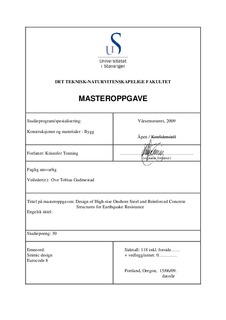| dc.description.abstract | The field of earthquake engineering and seismology is of great importance to
structural engineers around the world. Only by studying past seismic activity can we
predict, with a level of uncertainty, the occurrence of future earthquakes. The effects
of previous earthquakes are also of importance when studying and improving
seismic restraint systems in structures.
The location, size and consequences of an earthquake are variable depending on
several conditions. Surface conditions, boundary/fault type and distance from the
boundary and hypocenter are all elements that dictate the outcome of a seismic
event. Describing the effects of an earthquake can be difficult. Early records of
earthquakes date back to ancient civilizations. Studies of seismic activity were based
on descriptive observations. With the introduction of sensitive instruments, the
science of seismology has become much more accurate and it is easier to compare
seismicity globally.
The seismic design criteria specify the minimum seismic design requirements that
are necessary to meet the performance goals established for a specific structure.
These minimum requirements are generally outlined in the codes that are in effect at
a particular location. In the US, the earthquake design criteria are to conform to a
local code in each state, which is usually based on 2006 IBC and ASCE7-05.
Throughout the European countries, Eurocode 8 is being implemented as the
standard for seismic design.
A key step in developing the design criteria is to determine the peak ground
acceleration (PGA). This is easily measured by a seismometer or accelerometer.
The ground acceleration will decrease as the distance from the epicenter increases.
For this reason attenuation relationships describe the actual ground acceleration at
any site, based on the magnitude and distance from the source. This is incorporated into the seismic section of building codes, and is generally not addressed in the
design process. ASCE 7-05 uses mapped acceleration parameters that are obtained
from the 0.2 and 1.0 s spectral response accelerations shown on maps prepared by
the US Geological Survey. The Eurocode uses the peak ground acceleration as the
basis for the design spectrum, and these values are given on maps in the National
Annex of the code.
The International Building Code (IBC) is the authority of structural provisions used in
the United States. Due to the comprehensiveness of this code, most of the seismic
provisions are given in a publication by the American Society of Civil Engineers
(ASCE 7-05). The European code is reviewed with emphasis on the provisions for
Norway given in the National Annex. The Norwegian Standard (NS 3491-12) will not
be discussed here, because it is no longer the most current code used in design and
it is also largely based on the Eurocode.
The seismic criteria adopted by current codes involve a two-level approach to
seismic hazard. The basic criterion in Eurocode 8 is a level of ground shaking that
has a 10% probability of being exceeded in 50 years (475 year return period).This
return period has also been used to define design basis earthquake in several of the
primary building codes in the United States that preceded the new International
Building Code (IBC). The 2006 IBC, through reference to the ASCE 7–05, uses twothirds
of the maximum considered earthquake (MCE) as the design earthquake. In
the United States, the MCE is defined as an event with an approximate 2,500-year
return period (2% probability of exceedance in 50 years). Although the two codes have certain differences, it is clear that they are both based
on a common understanding of earthquake behavior. The science behind the
provisions are founded on common scientific ground, and even though the analysis
approach differ in context, the results achieved closely correlate. | en |
